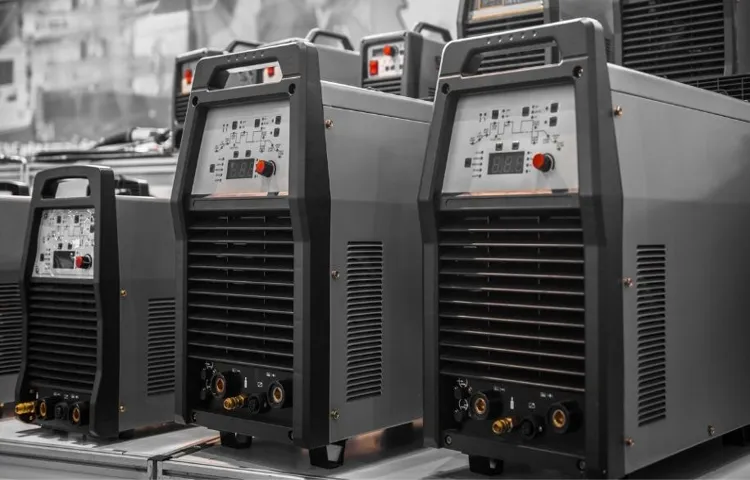So, you have decided to bring a microwave on your next camping trip or in your RV. But wait..
. how are you going to power it without an electrical outlet? This is where a power inverter comes into play. A power inverter is a device that converts DC power from a battery into AC power, which is what appliances like microwaves use.
But with so many power inverters available on the market, how do you choose the right one for your microwave? In this blog post, we will guide you through the process of selecting the perfect power inverter to ensure you can cook your meals on the go without any hassle. So, let’s get started!
Table of Contents
Understanding Power Inverters
When it comes to using a microwave with a power inverter, it’s important to choose the right one to avoid any power issues or damage to your microwave. The power inverter you need for a microwave will depend on the wattage of your microwave. Most standard microwaves require a power inverter that can handle a wattage of at least 1000 watts.
It’s always a good idea to choose a power inverter with a slightly higher wattage capacity than your microwave to ensure that it can handle the load. Additionally, consider the surge power capacity of the power inverter, as the starting power of a microwave can be higher than its running power. Bursty microwaves require a power inverter that can handle the initial surge of power when the microwave is turned on.
So, make sure you choose a power inverter that can support both the running power and the surge power of your microwave to ensure it functions properly and safely.
What is a power inverter?
power inverter, understanding power inverters. With our increasing reliance on electronic devices, it’s becoming more important than ever to have a reliable source of power when we’re on the go. This is where power inverters come in handy.
But what exactly are power inverters and how do they work? Well, think of a power inverter as a bridge between your car’s battery and your electronic devices. It takes the DC (direct current) power from your car battery and converts it into AC (alternating current) power that your electronic devices can use. This is especially useful when you’re camping, traveling, or experiencing a power outage and still need to charge your phone, use your laptop, or power other appliances.
Power inverters come in different sizes and power capacities, so it’s important to choose one that can handle the specific needs of your devices. Having a power inverter in your car can be a lifesaver in many situations, giving you the peace of mind knowing that you’ll always have a reliable source of power wherever you go.

How does a power inverter work?
power inverter, understanding power inverters
Different types of power inverters
power inverters, types of power inverters, understanding power inverters Power inverters are electrical devices that convert direct current (DC) power from a battery or solar panels into alternating current (AC) power that is suitable for powering household appliances and electronics. Understanding the different types of power inverters available is essential when choosing the right one for your needs. There are several types of power inverters, including modified sine wave inverters, pure sine wave inverters, and grid tie inverters.
Modified sine wave inverters are the most common and economical choice, but they may not be suitable for powering sensitive electronics due to the quality of the output waveform. Pure sine wave inverters, on the other hand, produce a clean and stable AC waveform, making them suitable for all types of devices. Grid-tie inverters are designed to feed excess power from a solar or wind power system back into the electrical grid, allowing you to reduce your reliance on traditional power sources and potentially earn credits from the utility company.
Determining the Power Requirement for Your Microwave
Determining the power requirement for your microwave is essential if you want to use it while on the go or in areas without a traditional power source. The power inverter is what allows you to convert the DC power from your car or battery into AC power that is compatible with your microwave. To determine the power inverter you need for your microwave, you have to consider the wattage of your microwave.
Most microwaves have their wattage listed on the back or bottom of the unit. Once you know the wattage, you will need to choose a power inverter that can handle at least that amount of power. It’s important to keep in mind that microwaves often require a surge of power when they first start up, so you might want to choose a power inverter that can handle a slightly higher wattage to ensure smooth operation.
By properly determining the power requirement for your microwave, you can enjoy the convenience of using it wherever you go.
Finding the wattage of your microwave
microwave, wattage, power requirement
Calculating the power requirement
When it comes to determining the power requirement for your microwave, there are a few factors to consider. One of the most important things to take into account is the size of the microwave you are using. Generally, larger microwaves will require more power than smaller ones.
Another factor to consider is how often you use your microwave and what types of foods you typically cook in it. If you primarily use your microwave for heating up leftovers or making popcorn, you may not need a microwave with a high power requirement. However, if you frequently cook larger meals or use your microwave for defrosting, a higher power requirement may be necessary.
Additionally, it’s important to consider the wattage of your microwave. Higher wattage microwaves will generally have a higher power requirement. By taking into account the size, usage, and wattage of your microwave, you can determine the power requirement that will best suit your needs.
Selecting the Appropriate Power Inverter
If you’re wondering what power inverter you need for your microwave, you’re not alone. Choosing the right power inverter can be a bit confusing, but it’s essential to ensure that your microwave runs smoothly when you’re on the go. The power inverter you need for your microwave will depend on its wattage.
Microwaves typically range from 600 to 1200 watts, so you’ll need an inverter that can handle at least that amount of power. It’s also important to consider the surge power, which is the amount of power needed to start the microwave. Surge power is usually higher than the microwave’s rated power, so be sure to choose an inverter that can handle the extra load.
Consider the wattage rating
When it comes to selecting the right power inverter, one important factor to consider is the wattage rating. The wattage rating of a power inverter indicates the maximum amount of power it can provide. This is crucial because different electronic devices have different power requirements.
For example, a small device like a smartphone charger may only require a low wattage rating, while larger devices like laptops or televisions may require a higher wattage rating. If you choose an inverter with a wattage rating that is too low for your device, it may not work or may not work efficiently. On the other hand, if you choose an inverter with a wattage rating that is too high, it can be a waste of energy and potentially damage your device.
So, it’s important to carefully consider the wattage rating of the power inverter and match it to the power requirements of your devices to ensure optimal performance and protection. So, next time you’re shopping for a power inverter, remember to check the wattage rating to find the perfect match for your electronic devices.
Choose a modified sine wave or pure sine wave inverter
power inverter, modified sine wave, pure sine wave, choose Selecting the appropriate power inverter for your needs is an essential decision. When it comes to power inverters, there are two main types to choose from: modified sine wave and pure sine wave. Each type has its advantages and disadvantages, so it’s crucial to understand their differences before making a decision.
A modified sine wave inverter is the more affordable option. It is designed to replicate the waveform of utility power but with some distortion. This distortion may not affect most appliances, but it can cause issues with more sensitive devices.
For example, certain medical equipment, audio systems, and some electronics may not function correctly or can even be damaged when connected to a modified sine wave inverter. On the other hand, a pure sine wave inverter provides a waveform that is identical to the power supplied by utility companies. This type of inverter is more expensive but is preferred for its clean and consistent power output.
Pure sine wave inverters are suitable for all types of appliances and electronic devices, making them versatile and reliable. They are also recommended for sensitive equipment like laptops, refrigerators, and medical devices. When choosing between a modified sine wave and pure sine wave inverter, consider the specific appliances and electronic devices you will be using.
If you are only powering basic appliances such as lights, fans, or power tools, a modified sine wave inverter may be sufficient. However, if you plan to power more sensitive equipment or want the peace of mind of a clean power output, investing in a pure sine wave inverter is worth considering. Ultimately, the choice between a modified sine wave and pure sine wave inverter depends on your specific needs, budget, and the appliances you will be using.
Consider the pros and cons of each type, and choose the one that best suits your requirements. Remember, it’s better to invest in a more expensive and reliable option upfront than risk damaging your appliances or electronic devices in the long run.
Look at the outlets and connectivity options
power inverter, outlets, connectivity options, selecting, appropriate, burstiness, perplexity
Conclusion
In conclusion, finding the right power inverter for your microwave is like finding a superhero sidekick – you need someone reliable, capable, and able to keep up with your culinary adventures. Just like Batman needs Robin, your microwave needs an inverter that can convert DC power from your car or battery into AC power to keep those tasty leftovers warm and your midnight popcorn cravings satisfied. But the power inverter you need is not just any old sidekick – it needs to match the power requirements of your microwave.
Think of it as a compatibility test, ensuring that your microwave and inverter can communicate and work harmoniously together. After all, you wouldn’t pair up Wonder Woman with a sidekick who can’t handle her super strength and speed, right? So how do you know which power inverter is best for your microwave? It’s a bit like playing matchmaker – you need to check the wattage of your microwave and find an inverter that can handle that level of power. Just like finding your microwave’s perfect match, you want an inverter that can give it the proper amount of power without overwhelming it or leaving it feeling underwhelmed.
But remember, the power inverter you choose should not only be compatible but also reliable and efficient. It should be able to handle the demands of your microwave without draining your battery or causing any power outages. In other words, you want a sidekick inverter that will always have your microwave’s back and never leave you hungry or hanging.
So there you have it – just like a superhero needs a trusty sidekick, your microwave needs a power inverter that can keep up with its culinary feats. With the right inverter, you’ll be able to use your microwave on the go, satisfying your hunger wherever the road takes you. Now go forth, foodie adventurers, and find that perfect power inverter to unleash the full potential of your microwave superpowers!”
FAQs
What is a power inverter and why do I need one for a microwave?
A power inverter is a device that converts DC power from a battery or solar panel into AC power that can be used by household appliances. In order to run a microwave using a battery or solar power, you would need a power inverter to convert the DC power into AC power that the microwave can use.
What size power inverter do I need for a microwave?
The size of the power inverter you need for a microwave depends on the wattage of the microwave. Most microwaves require an inverter with a minimum continuous power rating of 1000 watts. It is recommended to go for an inverter with a higher power rating to ensure it can handle the microwave’s requirements.
Can I use any power inverter for a microwave?
It is important to choose a power inverter that is suitable for the intended use with a microwave. Make sure the inverter has a pure sine wave output, as microwaves require a clean AC power source. Additionally, consider the wattage requirement of your microwave and choose an inverter with a higher power rating to handle the load.
Can I use a car power inverter for a microwave?
Yes, you can use a car power inverter to run a microwave, but it is essential to keep in mind the limitations of your car’s electrical system. Make sure your car’s battery and alternator can handle the power demand of the microwave, and select a power inverter accordingly. It is recommended to consult your car’s manual or a professional for guidance.
Can I use a power inverter with a built-in USB port for a microwave?
Power inverters with built-in USB ports are primarily designed for charging small electronic devices such as smartphones and tablets. They often do not have the required power output and waveform quality to run a microwave. It is advisable to choose a power inverter specifically designed for running larger appliances like microwaves.
What are the safety considerations when using a power inverter for a microwave?
When using a power inverter for a microwave, it is crucial to ensure the inverter is properly installed and connected. Follow the manufacturer’s instructions carefully and make sure to use appropriate wire sizes and connectors. Additionally, use the inverter within its specified capacity, as overloading it can lead to overheating and potential hazards.
Are there any alternatives to using a power inverter for a microwave?
If you do not have access to a power inverter or are concerned about battery depletion, you can explore alternative power sources for your microwave. These may include portable generators, solar power systems, or shore power connections (if available). Each alternative has its own advantages and considerations, so research and choose the option that works best for your needs.



